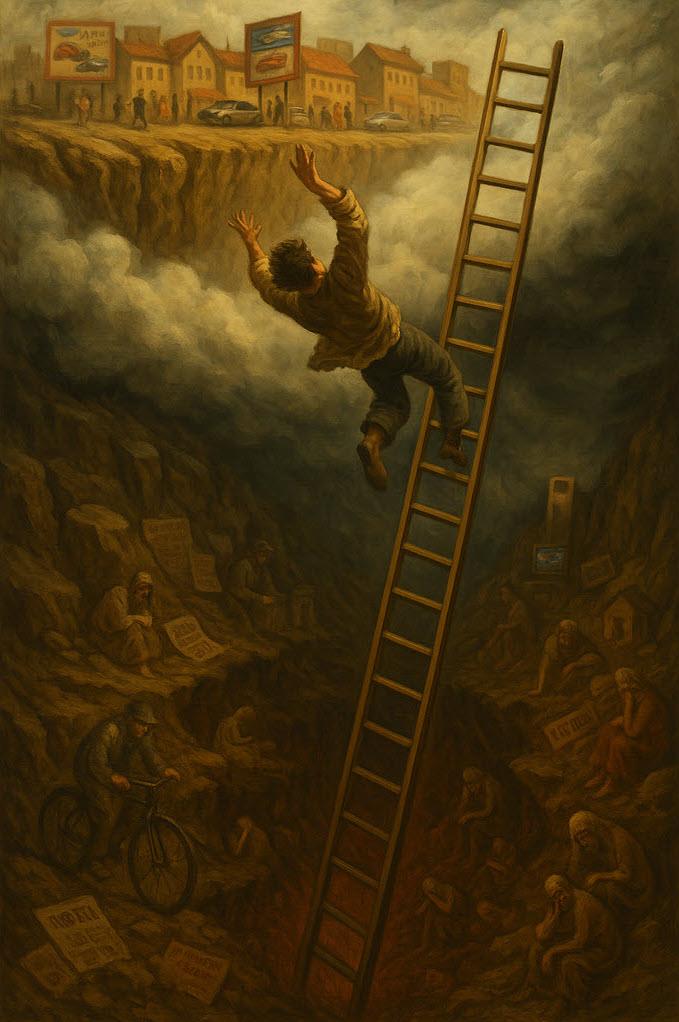Most people imagine the fall from society into poverty as a temporary setback, a stumble you can simply get back up and walk off. But that’s only because they’ve never seen what lies below the clouds.

In reality, the fall from ordinary American life is miles deeper than anyone can fathom. The climb from childhood to college, to military service or good jobs, is paved by the prosperity of our country — and you grow up believing the safety net is something you’ll never need.
From above, people often look down on those who fall, and thanks to divisive media, assign hurtful attributes such as: “lazy,” “unintelligent,” “flawed,” “needy,” “wanting something for free,” “criminal,” “dirty,” “beyond help.”
But the world seen from above has very little in common with the world beneath the clouds, where people have nothing — and no way out. That is why many may appear angry or defeated. They are not “bad people.” They are trapped in a place most Americans can’t imagine.
Above the Clouds — The Plateau of Society
Up there is the world most people know:
- clean streets
- steady work
- credit scores
- restaurants and healthcare
- new cars and predictable bills
- the promise of upward mobility
Above all – a home and healthcare without hunger – the pillars of society we take for granted where hope rests and happiness is within reach.
The Fall
When a person falls — from sickness, job loss, divorce, disability, fraud, addiction, criminal victimization, a financial shock, and often several of these at once — the drop is not a few feet.
It is freefall – You fall straight through the clouds into a world the people above cannot see.
Down there – at the bottom:
Your credit collapses,
- Then your rental history,
- Then your savings,
- Then your belongings, pawned off one by one,
- Then your dignity — as you go from independent to invisible.
- Then your belongings, pawned off one by one,
- Then your savings,
The food you eat changes. your transportation. clothes, address, friends, tools — all change.
You enter a version of America that looks nothing like the one you grew up in – or the one you only see on the TV/internet. Here, you don’t just lose things — you lose everything.
Every rung you once stood on is gone.
- You can’t rent an apartment.
- You can’t get a job that pays enough to escape.
- You can’t rebuild credit or rental history.
- And people treat you as if you are the sole cause of your own fall.
Meanwhile, those above the clouds look down, see nothing, and assume the bottom is just a step down — climbing back up will be easy.
But from below, that climb seems like scaling mount Everest. People above will call it “dependency.” People below call it “survival.”
But the truth is simpler:
You don’t stay at the bottom because you want to. You stay because there’s no way out.
Until someone builds one.
The Climb
SafetyNet 2.0 is a ladder rising out of this abyss. A ladder that cuts through the clouds. A ladder that restores what people at the bottom have been denied for far too long:
A real way up. A real way out. A reason to climb. Hope.
Yet the truth is, most people will not be able to climb all the way back to society’s upper plateau — not because they lack character, but because the fall is too deep, the damage too great, and the systems above too unforgiving.
SafetyNet 2.0 doesn’t pretend otherwise. Instead, it offers realistic mobility:
- a stable tiny home
- a self-governed, safe community
- access to public transportation
- no garages, no driveways, no unaffordable expectations
- walkable neighborhoods
- dignity at the base level of life
From this new plateau — many will finally find the pillars of society, that all of us most depend on.
A place to call home and a community to be part of!
But it’s not given, it’s earned – you have to climb the ladder – only then will it have the kind of value that’s truly appreciated!
That is the promise of SafetyNet 2.0.
The best part – this does not cost the taxpayers any more money – these are put together by local investor-developer teams, incentivized by the great ROIs afforded by HUD’s small FMR, and the guaranteed payments by HUD’s housing choice vouchers.